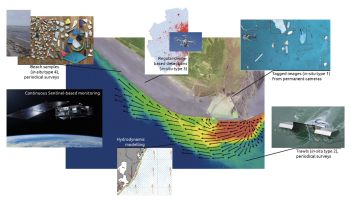Monitoring areas closer to plastic marine litter sources such as rivers and estuarine systems has the potential to improve mitigation strategies. Upscaling in situ litter point data with earth observation (EO) and hydrodynamic models is our central concept. Sentinel-2 and -3, together with data from similar satellite missions, will be used to monitor discharging rivers and their estuaries based on river plume detection inferred from suspended particulate matter maps. Multi-type in situ data will be collected at various points along the pollution pathway. Imagery taken from installed cameras on bridges or other infrastructure will be analyzed using deep-learning approaches in order to detect floating plastic in rivers (in situ type 1). This will provide improved inputs to transport models. Water samples from estuaries and coastal areas using manta trawls (in situ type 2) are used to quantify plastic litter abundances. High-resolution monitoring via automated analysis of drone imagery along the shoreline (in situ type 3) will be established for accumulation analyses as well as collecting beach samples through field surveys (in situ type 4). Integration of in situ data, multi-scale EO and hydrodynamic modelling serves as the development basis for a monitoring system of plastic debris in aquatic ecosystems, allowing for the first time an end-to-end depiction of real-world debris transport pathways. Three fundamental steps are needed: (1) scaling point measurements to large-area observations (in situ + EO), (2) modelling transport pathways through both fore- and hindcasting (in situ + current modelling), and (3) assimilation of EO data to improve model accuracy (current modelling + EO).Such source-to-sink monitoring systems can be used to identify environmental, economic, human health and safety-related impacts of plastic litter and would support targeted efforts of both off- and onshore-based clean-up projects by focusing on smaller areas with higher plastic abundances.

